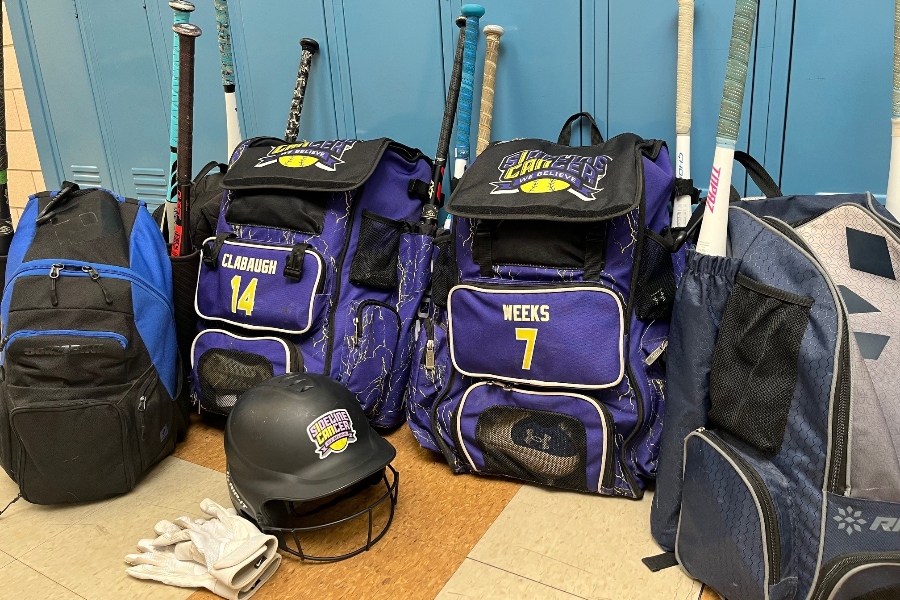As a parent you want your kids to do what they enjoy, but what if their passion is a never ending cash grab?
Playing sports is great for kids as it teaches them life lessons and keeps them active; however, every season it seems like they need new overpriced equipment.
This article will focus specifically on the rising price of playing baseball and softball, which may be the biggest offenders. We’ll delve into the enormous costs of basic equipment and question if travel baseball/softball is worth the big price.
PLAYING THE GAME IN TERMS OF DOLLARS AND CENTS
At the most basic level, players need a helmet, a bat, a glove, and cleats to play softball or baseball. This may not sound like a lot, but these four things can rack up a pretty big total at the cash register. The average cost of a bbcor bat, which is the certification required for a bat in high school baseball, is between $250-$500 and a glove can cost somewhere in the same range. Then add another $50 for a helmet. Players are going to want to get a pair of cleats too, and an average pair costs between $70-$100.
To carry all of that equipment, most players purchase specialized bags, and a bag from Boombah, one of the top-of-the-line products, can cost anywhere from $90 to $130.
You also can’t forget that you need the clothes and the unneeded accessories that all kids want nowadays. Kids today add arm sleeves, wrist tape, sunglasses, etc to their uniform and these accessories will add up. Also it’s not unusual for high school athletic departments to pass the cost of pants on to the players, which is the case for softball at Bellwood-Antis. If pants aren’t provided for you, they will run you about $45 and unless you want to constantly be doing laundry you might want to buy multiple pairs. Many leagues and high school teams even require players to purchase their own socks and belts to go with their uniforms.
“Especially in the last 10 years or so, youth sports has become big business,” said Bellwood-Antis baseball coach Adam Plummer, who played for B-A in the early 2000s when, he said, a high-end bat cost around $250. “Basic high school bat models now start at $250, with the high-end reaching $450. Prices increased over time for many reasons, like year-over-year inflation and advancement in technology.”
The above costs are only accounting for parents having one child playing, but consider the total costs if they have multiple children participating in baseball/softball.
High school English teacher Mr. Kerry Naylor, who coaches junior high softball in Tyrone, has multiple children who play softball and baseball, and he has seen how quickly the costs can pile up.
“I have two daughters who play softball and last year both of them needed new gloves,” he said. “Our thinking was if we bought quality gloves they could last their entire high school careers. In the end we ultimately paid almost $700 for 2 gloves. Later, our youngest daughter was moved to catcher, but teams don’t provide that gear so we had to buy that. In one season, not even including travel, we had paid more than $1,400. It was crazy.”
BACK IN THE DAY
This is a big change from when many parents, teachers, and adults played. Assistant baseball coach Mr. Tom Partner, who graduated in 1994 and played baseball for the Blue Devils, has seen the problem firsthand.
“Previously, the majority of the players would use team bats and team helmets, and the only equipment bought would be a pair of cleats and a glove. Even the catcher would often use the team gear,” he said. “However, it is rare for a player today not to have his or her own bat and helmet, and catchers are spending hundreds of dollars on their own catcher’s equipment.”
B-A junior high softball coach Mrs. Allison Stinson has an experience similar to Mr. Partner’s.
“When I played, we had a team set of just about everything. We had team bats, team helmets, and team catchers equipment,” Mrs. Stinson said. “No one had bat bags, rather just a duffle bag to carry your uniform, glove, and cleats in. Today, both in junior high and travel ball, my players have bat bags ($60-$100), many have multiple bats ($100 – $400 each), their own helmets ($60-80) in addition to face masks ($30), gloves ($60-$150) and cleats ($50-75). There is A LOT of money in each of those bags that they carry around.”
Baseball and softball have always been popular sports for young kids to play, but in the future it could change to less expensive sports such as soccer, basketball, and track and field.
Last year, Mr. Naylor’s son took a year off of baseball, but decided this year he wanted to play again this season.
“You always want what’s best for you kids, but we’re just buying the essentials and spending thousands,” he said. “I loved it when my son only ran track in the spring and we just paid $75 for a pair of spikes.”
Baseball and softball have become so expensive compared to other popular sports that it makes sense that parents might want to push their kids in another direction.
Players in America seem to live by the notion of look good, play good, but that mantra is quickly becoming a statement to justify unneeded accessories. Young kids in America seem to think the more money they spend the better they will be, but for a counter argument one need only to look at the Dominican Republic and Venezuela, who combine to make up 18.5% of the players in the MLB. Both of these countries are riddled with poverty, but produce some of the greatest baseball players in the world. Players like Juan Soto, Fernando Tatis Jr., Manny Machado, and Ronald Acuna Jr. come from these two countries and didn’t grow up with all the expensive equipment; however, they are the faces of the MLB and are the biggest marketing pieces the company has. American companies use these players in marketing strategies to make money off of caring parents that want to see their kid succeed, but these players made it to the MLB without any of the expensive equipment or accessories they are advertising.
TO TRAVEL OR NOT
The other driving factor of rising costs is the price to play for a travel baseball/softball organization.
Travel baseball/softball has gained a lot of traction in the past decade and the costs to play have risen to upwards of $800 just to join local teams like Super Swing and Flood City.

“If a player chooses to play extra ball, the costs will most likely exceed a couple of thousand dollars, which include equipment, uniforms, team registration dues and tournament fees, and hotel stays,” said Mr. Partner.
The rising costs beg the question: is travel baseball/softball worth the price?
“That has to depend on the individuals involved—the travel experience can be very rewarding because one is getting extra at-bats at the plate, innings on the mound, and playing time in general on fields that he or she wouldn’t normally play on and against players that he or she wouldn’t play,” Mr. Partner said. “The team often consists of various players from different areas coming together to compete, have fun, and get better. Plenty of friendships and memories are made whether it’s a win or a loss. In addition, any experience is a great experience if one can learn from it and become a better player and person. So, again.. is it worth it? I guess you could say it depends on the individual and the experience that he or she has had.
Mrs. Stinson, who was a standout pitcher at Moshannon Valley in the 1990s before pitching in college at Clarion, played travel softball herself, and now her daughter plays. Mrs. Stinson has seen the rise in costs, but she has also seen the new opportunities it has opened.
“With costs rising for everything, from equipment to tournament registration to umpire fees, it can be overwhelming and make it harder for some to be able to participate in travel ball,” she said. “Many local organizations are beginning to provide leagues for girls in middle/high school to continue to play in the summer, even if it’s not at the travel ball level.”
Despite the costs, the experience can be quite valuable, Mrs. Stinson said, and of all her softball memories it’s the time with her travel teams she would choose to go back and revisit.
“We had a really great team, but it honestly isn’t even about the wins and losses and championships, but the friendships that I made with girls from all over the place that I would have never had a chance to meet,” said Mrs. Stinson. “These friendships have withstood the test of time and I continue to have these amazing people in my life from our days on the softball field. It is also more about the memories, not only on the field, but off, and the lessons I learned about winning and losing with grace! As I get to experience travel ball again with my own daughter, I am overwhelmed with gratitude for the opportunities that my parents gave to me in allowing me to play summer ball. Watching my Lainey forge relationships with school ball teammates and opponents brings my heart such joy and I know that these are the things that she will remember long after she hangs up her cleats.”
One cost of travel sports that doesn’t show up on a receipt is the cost in time, and that could force families away from the sport, as well. The enormous time investment could also force athletes to choose between playing multiple sports or focusing on their travel sport.
Head baseball coach Adam Plummer has two sons that have played travel baseball, but he thinks kids should explore all their options during their youth instead of dumping so much money into one sport.
“I always encouraged my kids to play a different sport each season. My kids did play travel baseball and we were able to do that as a family, but that was also understood in doing so, it would not affect their other sports,” Coach Plummer said. “As a baseball coach, if a mother asked me if their child should play football or sign up for extra baseball in the fall, my answer would be football 100 times out of 100 times. Those that choose one sport, it might be for them. But I would encourage multiple, and if that means missing out on an extra season of baseball due to costs, that’s what I would choose.”
THE FUTURE OF THE GAME
In general, youth sports participation has taken a hit of late. One survey in 2021 found that youth participation in team sports had declined 45% since 2008.
It was also found that 70% of kids quit their sport by the age of 13. some lost interest, others don’t like the cutthroat competition, some are bruedn out, and others just aren’t having fun anymore.
However, one thing is certain:
The price of a sport shouldn’t be the reason kids stop playing.








